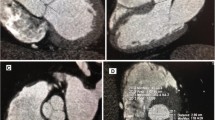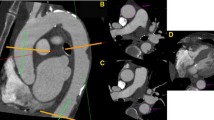Abstract
Objectives
To gain a new insight into the elastic properties of the thoracic aorta in patients without aortic diseases using electrocardiographically (ECG)-gated dual-source (DS) CT.
Methods
56 subjects with no cardiovascular disease, selected from 2,700 people undergoing ECG-gated DSCT examination, were divided into three groups according to their age. CT data were reconstructed in 5% step throughout the RR interval. Diameter and area were measured at the curve of the ascending aorta (AA) and at the same level of the descending aorta (DA). The pulsation and elasticity of the aorta were evaluated.
Results
Aortic diameter changes were noted throughout the cardiac cycle. The maximum average diameter was seen at an RR interval of 24.02 ± 4.99% for the AA and 25.63 ± 4.77% for the DA. The minimum was at 93.5 ± 4.04% for the AA and 96.6 ± 4.58% for the DA. There was an age-dependent decrease in elasticity, while different correlation coefficients were found between various age groups and different elastic parameters.
Conclusion
The properties of aortic pulsation and wall elasticity could be well shown by ECG-gated DSCT. The new findings regarding segment difference and age relevance were significant and should be taken into account in clinical trials and treatments for the elasticity related cardiovascular diseases.





Similar content being viewed by others
References
McEniery CM, Wilkinson IB, Avolio AP (2007) Age, hypertension and arterial function. Clin Exp Pharmacol Physiol 34:665–671
Glasser SP, Arnett DK, McVeigh GE et al (1998) The importance of arterial compliance in cardiovascular drug therapy. J Clin Pharmacol 38:202–212
Peralta CA, Adeney KL, Shlipak MG et al (2010) Structural and functional vascular alterations and incident hypertension in normotensive adults: the multi-ethnic study of atherosclerosis. Am J Epidemiol 171:63–71
Van People NM, Grobbee DE, Bots ML et al (2001) Association between arterial stiffness and atherosclerosis: the Rotterdam Study. Stroke 32:454–460
Kingwell BA, Waddell TK, Medley TL et al (2002) Large artery stiffness predicts ischemic threshold in patients with coronary artery disease. J Am Coll Cardiol 40:773–779
Cheung N, Sharrett AR, Klein R et al (2007) Aortic distensibility and retinal arteriolar narrowing: the multi-ethnic study of atherosclerosis. Hypertension 50:617–622
MacSweeney ST, Powell JT, Greenhalgh RM (1994) Pathogenesis of abdominal aortic aneurysm. Br J Surg 81:935–941
Lalande A, Khau Van Kien P, Walker PM et al (2008) Compliance and pulse wave velocity assessed by MRI detect early aortic impairment in young patients with mutation of the smooth muscle myosin heavy chain. J Magn Reson Imaging 28:1180–1187
Zhang J, Fletcher JG, Vrtiska TJ et al (2007) Large-vessel distensibility measurement with electrocardiographically gated multidetector CT: phantom study and initial experience. Radiology 245:258–266
Ganten M, Krautter U, Hosch W et al (2007) Age related changes of human aortic distensibility: evaluation with ECG-gated CT. Eur Radiol 17:701–708
Weber TF, Ganten MK, Böckler D et al (2009) Assessment of thoracic aortic conformational changes by four-dimensional computed tomography angiography in patients with chronic aortic dissection type b. Eur Radiol 19:245–253
O’Rourke MF, Staessen JA, Vlachopoulos C et al (2002) Clinical applications of arterial stiffness; definitions and reference values. Am J Hypertens 15:426–444
Wilson KA, Hoskins PR, Lee AJ et al (2000) Ultrasonic measurement of abdominal aortic aneurysm wall compliance: a reproducibility study. J Vasc Surg 31:507–513
Godia EC, Madhok R, Pittman J et al (2007) Carotid artery distensibility: a reliability study. J Ultrasound Med 26:1157–1165
Vulliémoz S, Stergiopulos N, Meuli R (2002) Estimation of local aortic elastic properties with MRI. Magn Reson Med 47:649–654
Malayeri AA, Natori S, Bahrami H et al (2008) Relation of aortic wall thickness and distensibility to cardiovascular risk factors (from the Multi-Ethnic Study of Atherosclerosis [MESA]). Am J Cardiol 102:491–496
Horiguchi J, Kiguchi M, Fujioka C et al (2008) Radiation dose, image quality, stenosis measurement, and CT densitometry using ECG-triggered coronary 64-MDCT angiography: a phantom study. Am J Roentgenol 190:315–320
Ganten MK, Krautter U, von Tengg-Kobligk H et al (2008) Quantification of aortic distensibility in abdominal aortic aneurysm using ECG-gated multi-detector computed tomography. Eur Radiol 18:966–973
Flohr TG, McCollough CH, Bruder H et al (2006) First performance evaluation of a dual-source CT (DSCT) system. Eur Radiol 16:256–268
Jin S, Oshinski J, Giddens DP (2003) Effects of wall motion and compliance on flow patterns in the ascending aorta. J Biomech Eng 125:347–354
Sokolis DP (2007) Passive mechanical properties and structure of the aorta: segmental analysis. Acta Physiol (Oxf) 190:277–289
Nelson AJ, Worthley SG, Cameron JD et al (2009) Cardiovascular magnetic resonance-derived aortic distensibility: validation and observed regional differences in the elderly. J Hypertens 27:535–542
Rogers WJ, Hu YL, Coast D et al (2001) Age-associated changes in regional aortic pulse wave velocity. J Am Coll Cardiol 38:1123–1129
Oishi Y, Mizuguchi Y, Miyoshi H et al (2008) A novel approach to assess aortic stiffness related to changes in aging using two-dimensional strain imaging. Echocardiography 9:941–945
Liang YL, Teede H, Kotsopoulos D et al (1998) Non-invasive measurements of arterial structure and function: repeatability, interrelationships and trial ample size. Clin Sci 95:669–679
Schmitt M, Avolio A, Qasem A et al (2005) Basal NO locally modulates human iliac artery function in vivo. Hypertension 46:227–231
Muntinga JH, Heesen WF, Smit AJ et al (2000) Isolated systolic hypertension from a vascular point of view. J Vasc Res 37:485–493
Ohte N, Saeki T, Miyabe H et al (2007) Relationship between blood pressure obtained from the upper arm with a cuff-type sphygmomanometer and central blood pressure measured with a catheter-tipped micromanometer. Heart Vessels 22:410–415
Acknowledgements
The authors thank Siemens healthcare for their prototype software and technical assistance. Thanks to Dr Yanhua Duan and Dr Dawei Wu for their help on patients collection.
Author information
Authors and Affiliations
Corresponding author
Rights and permissions
About this article
Cite this article
Li, N., Beck, T., Chen, J. et al. Assessment of thoracic aortic elasticity: a preliminary study using electrocardiographically gated dual-source CT. Eur Radiol 21, 1564–1572 (2011). https://doi.org/10.1007/s00330-011-2077-7
Received:
Revised:
Accepted:
Published:
Issue Date:
DOI: https://doi.org/10.1007/s00330-011-2077-7




